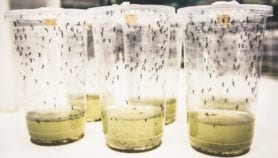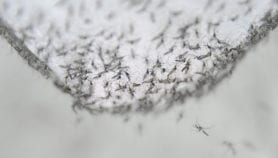By: Daniel Nelson
Send to a friend
The details you provide on this page will not be used to send unsolicited email, and will not be sold to a 3rd party. See privacy policy.
The discovery of "snorkel" genes that enable rice to survive underwater may lead to yield increases in lowland areas that flood frequently in the rainy season, say researchers.
In a letter published in Nature today (20 August), a team of Japanese researchers led by Motoyuki Ashikari, a professor at the Bioscience and Biotechnology Center at Nagoya University, say they have identified two genes that allow deep-water varieties to elongate their stems as water rises, helping the plant keep its leaves above water.
Importing the genes ‘SNORKEL1’ and ‘SNORKEL2’ into varieties that do not usually survive in deep water stopped the plants drowning. Once under water, their adopted genes switched on the process by which the stems became elongated.
Ashikari told SciDev.Net that the two genes and their molecular mechanism were previously unknown.
He says he hopes that the team’s work will help increase production in flood-prone areas, and that he is now aiming to develop new, high-yielding varieties with deep-water characteristics.
Thirteen years ago, David Mackill, now head of the plant breeding, genetics and biotechnology division of the International Rice Research Institute (IRRI) in the Philippines, and his then graduate student Xu Kenong announced the discovery of a gene, Sub 1A, that allowed an Indian variety to survive submersion for more than two weeks.
Last December, researchers said that the rice, known as ‘scuba’ rice, had passed its field tests with "flying colours" (see Waterproof rice passes international field tests).
Ashikari says that Sub1A is effective for short periods of flooding, but SNORKEL1 and SNORKEL2 function in heavy, long-duration floods.
Laurentius Voesenek of Utrecht University in the Netherlands, who wrote a commentary on the findings in Nature, says that both the Sub1A and SNORKEL genes are regulated by accumulated ethylene inside the submerged plant.
"Many relevant crop species are very intolerant to water-saturated growth conditions," he says.
"During selection for yield, traits related to flooding tolerance are largely lost in these crops. Very often, wild relatives still contain these genes. They should be identified and subsequently introduced in good yielding cultivars."
About 30 per cent of rice acreage in Asia and 40 per cent in Africa are rain-fed paddies exposed to fluctuating water levels.
Sophie Clayton of IRRI told SciDev.Net that Bangladesh and India are the countries with most to gain from flood-tolerant rice. She pointed out that in the Philippines alone, around 370,000 hectares of rice-growing land experiences flooding, causing average crop losses of about 250,000 tonnes every year.













